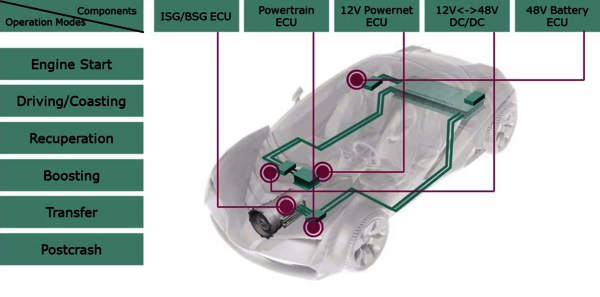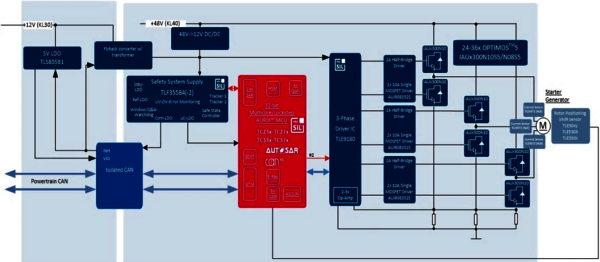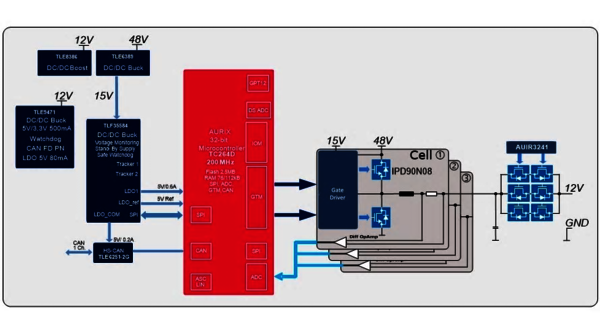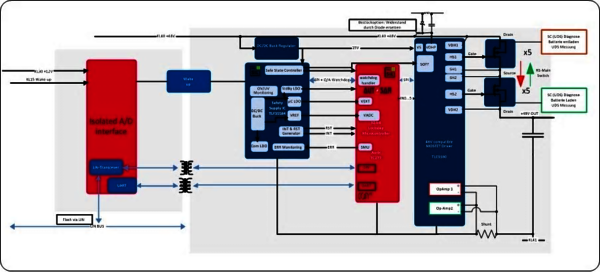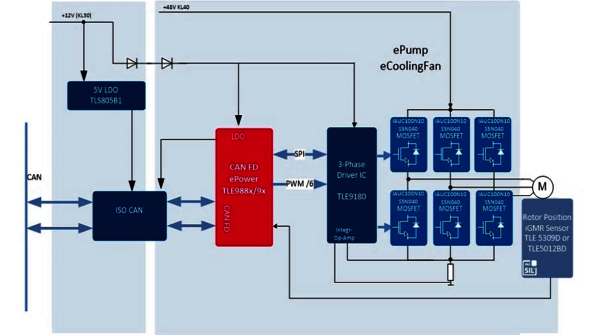Infineon’s 48V Solutions for Mild-Hybrid Electric Vehicles
Overview Page
Description:
Economic, environmental and social reasons changed in the last years the one way development of new and better combustion engine based powertrain solutions in the automotive environment. Over the years regulations with the target to reduce the CO2 emissions forced the OEMs to look for alternative techniques to reduce the fuel consumption of ICE (Integrated Combustion Engine) or even to replace the engine by an electrical drive train. From 2021 onwards the vehicle emission regulation directs a limit of 95gCO2/km (today 130g/km) which cannot be achieved with a further improvement of the ICE efficiency. An additional CO2 saving can be achieved by adding an electrical motor to support the various operational states of a car and which allows a reoccupation of energy into a battery. This concept led to the development of different types of hybrid electrical vehicles, such as plug-in hybrid electric vehicles, full hybrid electric vehicles and mild hybrid electric vehicles (MHEV). Depending on the type of hybridization a CO2 saving of up to 50% can be reached. From the commercial point of view the MHEV is the most economical type where the invest per saved gram of CO2 is the lowest. The additional applications in a MHEV typically require power compared to applications in a car with just an ICE. To enable and supply these applications used in a MHEV, a higher voltage level is required. As a compromise (trade off) between safety specifications and the power needed an additional power network at 48V was established. In 2016 the first production car with a 48V system architecture entered the market and more and more OEM offer mild hybrid models with a 48V architecture.
Benefits of 48V:
- The main benefit of a 48V network with its typical applications is the reduction of the CO2 output
- This is realized mainly by the recuperation of energy but also driving support by the starter generator is a benefit of the 48V network.
- New comfort features which need a higher power density are as well an advantage of the second power network in a MHEV.
- Further auxiliary applications which consume high power can be moved from the 12V network to the 48V side. This allows realizing an even more stable 12V power network.
48V Architecture
48V Architecture from P0 to P4 Generation
First Car on the Road with 48V:
The Audi SQ7 was the first car on the road with a 48V power network. It was not implemented to provide hybrid functionality, it was just invented to enable performance and comfort features which need for a short time a high energy input. This high power demand can be provided by a 48V lithium ion battery. All other applications consuming electrical energy are supplied by the 12V net. Even the generator is supplying the 12V net and the power for the 48V is provided via a DC/DC converter from the 12V power net.
P0-3 Generation:
The SQ7 is the first and the last of his kind. In a 48V subnet the essential role has the Starter Generator (SG) and therefore can also be called the heart of a MHEV. With the starter generator two essential applications are enabled which make the combustion engine driven car to a mild hybrid electric vehicle. For driving (limited) the SG can support or drive the car with up to 15kW of power. Energy recuperation is the second key feature of a MHEV. Due to the more powerful 48V subnet more energy can be regained and transferred into the battery. In a simplified approach, the generations P0-P2 differ only if there is a belt driven SG or an integrated SG used and where the integrated SG is mounted. Is it belt driven (P0)? Merged into the crankshaft (P1), into the transmission (P2) or is it even transmission mounted (P3).
P2-4 Generation:
More and more applications consuming higher power are moved to the 48V subnet. Heater or auxiliary drives such as water pump or engine cooling fan can be supplied by the 48V net. Generation P4 vehicles have an electric axle and AWD/4WD (all-wheel) on demand is feasible.
Key Benefits:
- Overall savings: 6 to 8% CO2
- Comfort features and increased performance
- Starter generator (smooth starting and boosting function)
- (48V battery (Li-Ion / Super-Cap) incl. BMS & main switch)
- Bidirectional DC/DC converter, possible complementary supply of the two power networks
Key Benefits:
- Overall savings: up to 20% CO2
- Increased boosting performance + recuperation power
- Beltless starter generator
- Electric air charger/compressor (eAC)
- Sailing & predictive driving (ICE off @ city traffic, parking, coasting)
- Low point shifting
- Torque vectoring (without differential)
48V Applications
Starter Generator:
The central element in the 48V network of a MHEV is the SG. On one hand it generates the energy to supply the 48V applications and charge the battery. On the other hand it starts the combustion engine and supports the ICE with boost functionality while the car accelerates. Depending on the generation (P0-P4) of the hybrid functionality, it also enables the so called sailing. As a third important functionality it allows the recuperation of energy into the power network (battery and applications) while the car decelerates.
DC/DC Converter:
As the second key element in a 48V system the DC/DC converter transfers energy between the 12V and the 48V domain. The main objective is to supply the 12V network with power. In the case the 48V domain needs power from the 12V side the DC/DC converter can as well transfer power to the 48V side.
Battery Switch (MOSFET gate driver)
A battery switch becomes also in the 12V network more and more state of the art. It is needed to disconnect the battery in case of an accident or connect and disconnect a second battery for grid stability and for power saving functionalities. To manage the power distribution a battery switch on the 48V side is in general required.
Auxiliaries drives (pump, water, fan, climate compressor…)
Any kind of applications which have a higher power consumption ( <1kW) and for this reason could destabilize the 12V network could be moved to the 48V domain. Typically these are any kind of motor control applications such as oil pump, water pump, climate compressor and engine cooling fans and maybe also some heating applications.
Product Highlights: (Additional 48V Products to Come in the Next Months)
|
Part Number |
Description |
|
Transistor MOSFET N-CH 80V 100A 8-Pin TDSON T/R |
|
|
OptiMOS 100V 300A HSOF-8 |
|
|
OptiMOS-5 Power Transistor MOSFET N-Channel 100V 260A 8-Pin PG-HSOF-1 T/R |
|
|
OptiMOS 100V 150A HSOF-8 |
|
|
Trans MOSFET N-CH 100V 100A 8-Pin PG-TDSON T/R |
|
|
Analog / Linear ICs (S&D, non Std., MPP) Part 1 |
|
|
AUDO (AUtomotive unifieD processOr) RISC/MCU/DSP processor core, this 32-bit TriCore microcontroller |
Contact Us

